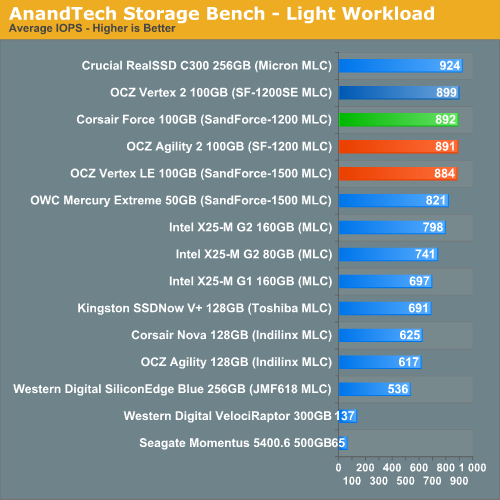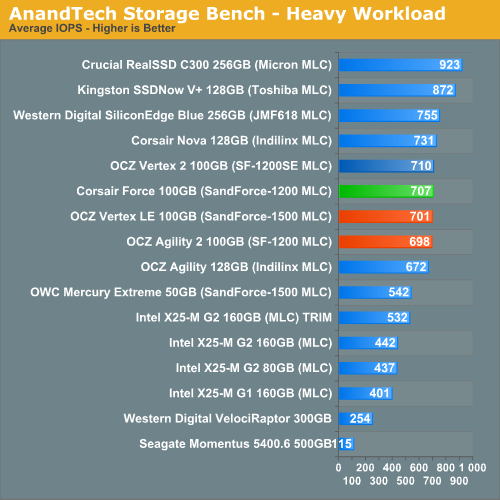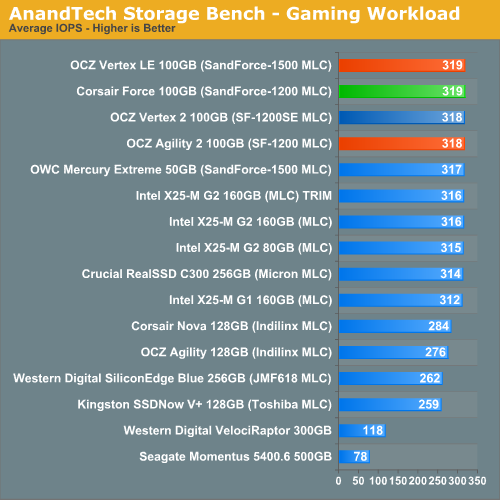OCZ's Vertex 2, Special Sauce SF-1200 Reviewed
by Anand Lal Shimpi on April 28, 2010 3:17 PM ESTAnandTech Storage Bench
Note that our 6Gbps controller driver isn't supported by our custom storage bench here, so the C300 results are only offered in 3Gbps mode.
The first in our benchmark suite is a light usage case. The Windows 7 system is loaded with Firefox, Office 2007 and Adobe Reader among other applications. With Firefox we browse web pages like Facebook, AnandTech, Digg and other sites. Outlook is also running and we use it to check emails, create and send a message with a PDF attachment. Adobe Reader is used to view some PDFs. Excel 2007 is used to create a spreadsheet, graphs and save the document. The same goes for Word 2007. We open and step through a presentation in PowerPoint 2007 received as an email attachment before saving it to the desktop. Finally we watch a bit of a Firefly episode in Windows Media Player 11.
There’s some level of multitasking going on here but it’s not unreasonable by any means. Generally the application tasks proceed linearly, with the exception of things like web browsing which may happen in between one of the other tasks.
The recording is played back on all of our drives here today. Remember that we’re isolating disk performance, all we’re doing is playing back every single disk access that happened in that ~5 minute period of usage. The light workload is composed of 37,501 reads and 20,268 writes. Over 30% of the IOs are 4KB, 11% are 16KB, 22% are 32KB and approximately 13% are 64KB in size. Less than 30% of the operations are absolutely sequential in nature. Average queue depth is 6.09 IOs.
The performance results are reported in average I/O Operations per Second (IOPS):

If there’s a light usage case there’s bound to be a heavy one. In this test we have Microsoft Security Essentials running in the background with real time virus scanning enabled. We also perform a quick scan in the middle of the test. Firefox, Outlook, Excel, Word and Powerpoint are all used the same as they were in the light test. We add Photoshop CS4 to the mix, opening a bunch of 12MP images, editing them, then saving them as highly compressed JPGs for web publishing. Windows 7’s picture viewer is used to view a bunch of pictures on the hard drive. We use 7-zip to create and extract .7z archives. Downloading is also prominently featured in our heavy test; we download large files from the Internet during portions of the benchmark, as well as use uTorrent to grab a couple of torrents. Some of the applications in use are installed during the benchmark, Windows updates are also installed. Towards the end of the test we launch World of Warcraft, play for a few minutes, then delete the folder. This test also takes into account all of the disk accesses that happen while the OS is booting.
The benchmark is 22 minutes long and it consists of 128,895 read operations and 72,411 write operations. Roughly 44% of all IOs were sequential. Approximately 30% of all accesses were 4KB in size, 12% were 16KB in size, 14% were 32KB and 20% were 64KB. Average queue depth was 3.59.

The gaming workload is made up of 75,206 read operations and only 4,592 write operations. Only 20% of the accesses are 4KB in size, nearly 40% are 64KB and 20% are 32KB. A whopping 69% of the IOs are sequential, meaning this is predominantly a sequential read benchmark. The average queue depth is 7.76 IOs.











44 Comments
View All Comments
marraco - Thursday, April 29, 2010 - link
The data compression accelerates the writing speed, but, the question is:The OS still considers that the non written space is occupied?
Or the compression releases the non used space?
I suspect that the unused space is marked anyways as used space, but I would like a confirmation.
TheHolmes - Thursday, April 29, 2010 - link
If Sandforce is largely about writing fewer bits to the NAND flash, wouldn't it also follow that turning on OS level compression would also work as well?Also, I'd be interested to know if using OS striping is ok with TRIM, as there aren't any controllers out there that work with TRIM when SSDs are striped.
cyrexo - Friday, April 30, 2010 - link
Hey Anand,have you put a Sandforce based disk into a mabook and let it running only on OSX?
Can you say something about speeddrops without Trim or does the build in "gc" wich isn't "gc" can handle it accurate?
i get my hands on a new I7 macbook and want to put a sdd into but i don't know if i should go for the old intels, use the new sandforce or wait some moths to see what intel does and how stable sandforce is without trim.
529th - Tuesday, September 28, 2010 - link
What is the verdict with these Vertex 2 100g SSD drives???Because I just got one in the mail from OCZ as a replacement for my dead Vertex LE 100G SF1500
Anand, care to comment as they have been in your desktop for ~ 5 months now.. or anyone who owns one???
Thanks,
529th
p.s. i am considering a main rig install with this, booting out my ever reliable 150g 1st gen Raptor...